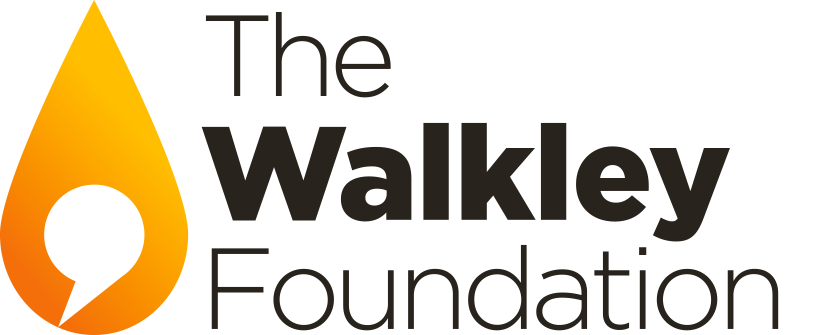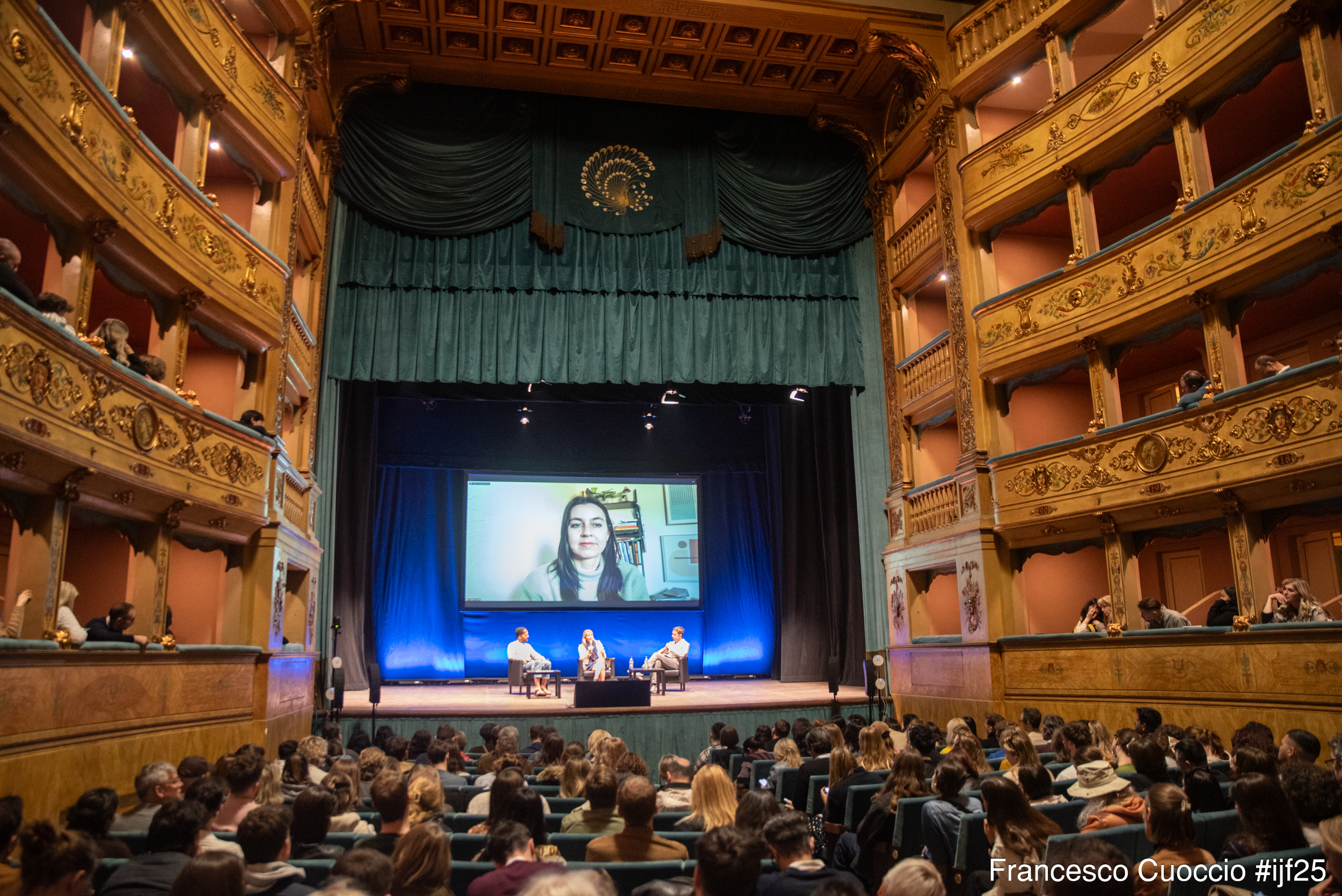CAPTION ABOVE: All Journalists are Content Creators panel at the International Journalism Festival, Perugia, in April. Picture: Francesco Cuoccio #IJF25
Rob Layton was a speaker and workshop convenor at the International Journalism Festival, and MojoFest. He is also Assistant Professor of Journalism at Bond University.
‘Creator Journalism’ and short-form video topped my must-see sessions at two recent international journalism events, as I investigate alternative pathways for students concerned about the sustainability of a career in journalism.
I was encouraged that both topics were prominent at the International Journalism Festival in Perugia – the supreme global journalism event, which should be on every journalist’s bucket list – and MojoFest in Dublin, where mobile journalists share latest technologies and practices in mobile-generated and consumed news.
Plenty of #IJF25 sessions interrogated alternative business models, press freedoms, fragmented audiences, mistrust in news (which Pew says has been growing for decades), AI-generated content, and myriad other challenges, but how students consume digital information guided my session choices.
But first, what is ‘creator journalism’? Essentially, it is an emerging field that blends traditional journalism with the techniques and approaches used by social media influencers and content creators. This form of journalism leverages the personal branding, storytelling, and audience engagement strategies typical of influencers to reach and resonate with new and diverse audiences.
It is also something publishers are in two minds about, according to the 2025 Reuters Digital News Report. That document says that more than a quarter of publishers “take a negative view, worrying that institutional news reporting could get squeezed out, but others (28%) are more positive, feeling that there is much that news organisations can learn in terms of storytelling creativity and building communities”.
It was those terms – storytelling creativity and building communities – that were my key takeaways, particularly at the #IJF25 panel ‘Digital content creators and journalists: shaping the future of news’, which discussed the increasingly blurred lines between traditional journalism and digital content creation. The panellists discussed how collaboration between these two groups can address critical challenges in the digital information landscape, such as misinformation, disinformation, and the erosion of public trust in news media.
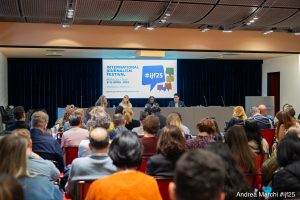
Digital Content Creators and Journalists panel at Perugia. Picture: Andrea Marchi #ijf25
The session emphasised the need for journalists and content creators to work together to harness their unique strengths. Journalists bring rigorous fact-checking and professional standards, while content creators offer creativity and a deep connection with their audiences.
Panellist V Spehar, host and creator of Under the Desk News, outlined their journey from being a TikTok news creator to collaborating with the LA Times and the Washington Post. V explained how an authentic and relatable approach helped build trust with audiences and how collaborations with traditional media outlets have been mutually beneficial.
Summer Harlow, associate director Knight Center for Journalism in the Americas, showcased the Center’s online course Digital Content Creators and Journalists: How to be a Trusted Voice Online and urged journalists to be more open to influencer collaborations.
The panel agreed they can help each other: journalists have content, but diminishing audiences; influencers have growing audiences, and need content. Further, journalistic content gives the creators credibility, and enables journalists access to niche markets.
It is apparent that a key ingredient in creator success – whether standalone influencer, or institutional figurehead – is personality, so this strategy may may not be for everyone. The Digital News Report said some publishers worry about “losing their editorial stars in a more personality-led ecosystem”.
For those in tune with this new style of journalism, it presents opportunities to not only build but to monetize audiences. That was the theme of ‘All Journalists Are Content Creators: It’s Time for Us to Embrace That’ with Mark Little, Taylor Lorenz, Jane Ferguson, and Johnny Harris.
Mark Little opened the session by highlighting the revolutionary shift in journalism, where journalists now have direct connections with their audiences. He emphasized that this new model allows journalists to engage and collaborate with their communities, creating a more interactive and responsive form of journalism.
Taylor Lorenz, known for her work with the New York Times and the Washington Post, and now running her Substack newsletter User Mag, discussed her mission to explain the online world in an accessible way. She noted that traditional media often framed her work for an older, less online audience, whereas her current approach allows her to engage directly with users on the platforms they frequent. Taylor highlighted the importance of transparency and interaction with her audience, saying, “I try to build stories in public with my audience so that they can make sure I get the story right and feel invested in it”.
Jane Ferguson, an award-winning foreign correspondent and founder of Newsphere, shared her goal to reinvent the distribution model of field reporting. She highlighted the need to cut out the middleman and make journalism a lucrative career again with direct audience engagement.
Johnny Harris, known for his work with Vox and his YouTube channel with more than 6.5 million subscribers, discussed his work to help people deeply understand complex issues.
The panelists noted that while independence offers creative freedom and direct audience engagement, it also requires journalists to develop entrepreneurial skills. Johnny said, “We can’t expect all of the best journalists to also want to be business owners and entrepreneurs with a high-risk tolerance”.
He and Taylor pointed out that serving the ‘attention economy’ can be crippling, and that collaboration among creators not only shares the load but better serves the audience.
Audience engagement was also centre stage at Mojofest 2025 in Dublin, where Jacque Smith, VP of Digital Video Production at CNN, delivered the keynote address: “Connection, Not Perfection: How to Find (and Keep) Your Future Video Audience”.
She emphasised the importance of building genuine connections with audiences over striving for perfect production quality. Jacque shared insights from her experience leading a global team of producers at CNN, highlighting how short-form videos can effectively capture attention and foster engagement by being relatable and timely.
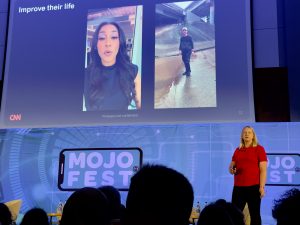
Jacque Smith, VP of Digital Video Production at CNN, on the MojoFest stage. Picture: Rob Layton
She shared the three-point strategy CNN applies to their videos:
- Why would anyone want to watch?
- The key is to create connection, focus on one character in the story;
- Tell the audience why they should care.
- Will it hold attention?
- Edit to engage;
- Avoid retention killers – stuffy tracks, long pauses.
- How would a creator tell this story.
- The creator takes the audience with them;
- The audience is part of the creator’s life;
- This builds trust.
Sandra Gathmann, host and co-creator of Al Jazeera’s Start Here and her team use short-form videos to introduce and lead into their more extensive video pieces. Start Here simplifies complex international news stories into 10-minute explainers, often accompanied by shorter clips for social media platforms like Instagram and TikTok. Metrics show audiences stay with the videos. Al Jazeera colleague Seena Khalil explained how her personalised shot-on-smartphone short videos of Qatar’s World Cup put AJ’s social audiences into the stadium.
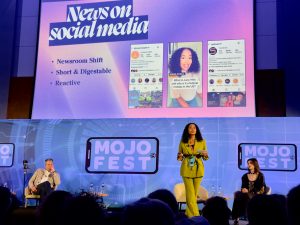
Seena Khalil, digital producer for Al Jazeera’s The Stream, explains how she produces news content for social platforms. Picture: Rob Layton
Masha Lavrova, a TikTok producer and video host at the Kyiv Independent, has played a crucial role in helping audiences understand the Russian invasion of Ukraine through her short-form videos. Masha’s content provides timely updates and on-the-ground perspectives, making the complex and evolving situation more accessible to viewers. Her videos often feature interviews with locals, footage from affected areas, and concise explanations of key events. She is young, passionate and relatable, and her work underscores the power of short-form video in delivering critical information quickly and engagingly, especially during times of crisis.
Evidently such strategies are working, as these journalists pioneer new paths, but creator journalism is still in its infancy and experimental stages. Even Johnny Harris and Taylor Lorenz seemed unsure of its future.
Traditional journalists may feel uncomfortable with the notion of creator journalism because it often emphasises personal branding and audience engagement over traditional journalistic standards and practices. This shift can lead to concerns about the dilution of journalistic integrity, the potential for misinformation, and the challenge of maintaining professional standards in a more personality-driven media landscape.
But it undeniably presents new opportunities for engaging audiences and innovating storytelling, and for early career journalists seeking alternative pathways. As the media landscape continues to evolve, embracing these changes could be key to a sustainable journalistic future.
* Note: Generative AI was used for YouTube transcription and summary of sessions, with human oversight and editing.
